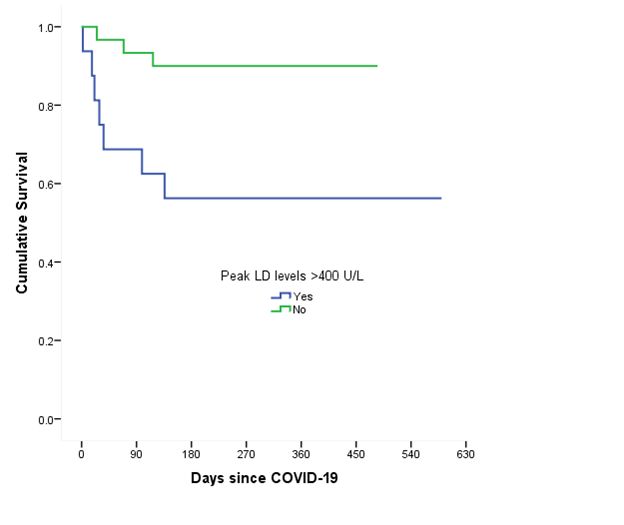Six-Month Outcomes Among Lung Transplant Patients with COVID-19
UT Southwestern Medical Center, Dallas, TX
Meeting: 2022 American Transplant Congress
Abstract number: 45
Keywords: COVID-19, Outcome, Prediction models
Topic: Clinical Science » Lung » 64 - Lung: All Topics
Session Information
Session Name: Infectious Considerations for Lung Transplantation
Session Type: Rapid Fire Oral Abstract
Date: Sunday, June 5, 2022
Session Time: 3:30pm-5:00pm
 Presentation Time: 4:10pm-4:20pm
Presentation Time: 4:10pm-4:20pm
Location: Hynes Room 210
*Purpose: There is limited data on the outcomes beyond the acute illness among lung transplant (LT) patients with Coronavirus disease 2019 (COVID-19). The current study sought to describe the predictors of 6-month survival among a single center cohort of LT.
*Methods:
We included all the LT patients diagnosed with COVID-19 during a one-year period (March 2020 to Feb 2021; n=54; median age: 60, 20-73 years; M:F 37:17). All patients completed at least 6-month follow up from COVID-19 diagnosis. We reviewed patient characteristics, presenting features, clinical course, and laboratory abnormalities at presentation and during the acute illness. We reviewed the hospital course and post-discharge outcomes including lung function loss among COVID-19 survivors. Median follow-up duration was 304 days. Six-month survival after COVID-19 was analyzed as the primary outcome variable.
*Results: Restrictive lung disease was the most common LT indication (n=41, 75.9%) and most had undergone bilateral LT (n=43, 79.6%). Patients were a median of 48 months (range <1-139 months) from their transplant. Majority of the patients required hospitalization (n=48) and significant proportion of patients developed respiratory failure (n=26). One month survival was 90.7% (n=49) while the survival dropped to 81.5% (n=44) by 6-month follow-up. On univariate analysis, females (35.3% vs 10.8%) and those with pre-existing chronic lung allograft dysfunction (CLAD, 33.3% vs 11.1%) experienced worse 6-month survival. Peak lactate dehydrogenase (LD) levels had the strongest association with 6-month survival on Mann Whitney U comparisons. On receiver operator characteristic curve analysis, the peak LD levels had an area under the curve of 82.9% (69.1-96.7%, p=0.002) with 400 U/L identified as the best cut-off. A peak LD level >400 U/L during the acute illness from COVID-19 was significantly associated with worse 6-month survival (OR, 95% CI: 4.38, 1.31-14.65, p=0.02).On Cox proportion hazard analysis, female gender (adjusted HR: 5.38, 1.13-25.64; p=0.035), pre-infection CLAD (5.63, 1.24-25.57; p=0.025) and peak LD levels >400 U/L (7.49, 1.72-35.53; p=0.007, see Figure for the Kaplan-Meier survival analysis) were independently associated with survival after COVID-19 among LT patients.
*Conclusions: COVID-19 is associated with significant mortality among LT patients with several patients succumbing beyond the period of acute illness. Female gender, established CLAD prior to COVID-19 and an LD>400 U/L at any time during the acute illness are adverse prognostic markers and may form the basis of customized management strategies.
To cite this abstract in AMA style:
Mahan LD, Rose J, Mohanka M, Banga A. Six-Month Outcomes Among Lung Transplant Patients with COVID-19 [abstract]. Am J Transplant. 2022; 22 (suppl 3). https://atcmeetingabstracts.com/abstract/six-month-outcomes-among-lung-transplant-patients-with-covid-19/. Accessed December 11, 2025.« Back to 2022 American Transplant Congress

